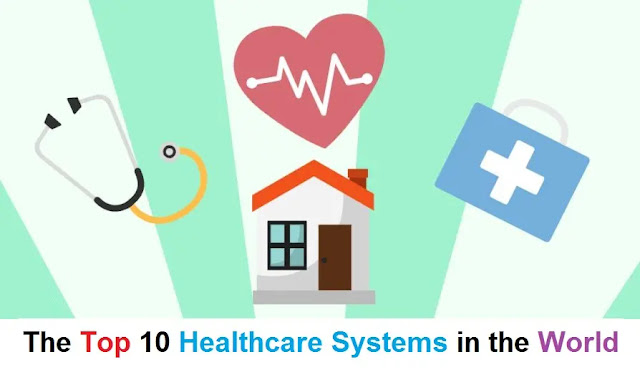According to the World Health Organization (WHO), the goals of a health care system are good health for the country’s citizens, responsiveness to the needs of the population, and fair means of funding processes. Pretty much, a good healthcare system is one that delivers high quality healthcare at a reasonable cost so everyone may “afford” to get sick or even take care of their most basic needs such as dental work, eye exams, and health check-ups.
When a country has a good healthcare system in place there seems to be more loyalty and respect for the powers that make it be. There is just something about being able to have your basic health care needs met without question that instills a deep sense of trust and pride for the country in which you reside.
The following ten countries are great examples of health care systems that work, even though for the most part, the way they work is vastly different from the next. What works for one may not work for the other, but when it comes to quality health care all that really matters is finding a system that works and supports its people.
The next time you’re wondering how your country’s health care system stacks up to the next, take a look at the following ten countries who all seem to be doing something right in the way it works for them. The people who live in these greatly different areas all have one thing in common. They are not suffering from ill-health because they can’t afford to pay for overpriced medical coverage or outrageous insurance premiums.Without further ado, here is the very best in healthcare found around the world.
1. Italy
The lifespan of the average Italian is 80.5 years, and part of this may be due to the fact that the people of Italy are assured to receive the quality healthcare they need. Most residents don’t need to carry private insurance because the government offers to take care of most of their health care needs without the necessity to pay out of pocket.
They have one of the lowest rates of health care spending per capita when you look at other first world nations like the United States, Canada, and the United Kingdom. In 2000, Italy’s healthcare system was voted number 2 in the world after France.
Prescription medication can only be provided with a doctor’s prescription, and only requires co-pay based on the medication and the patient’s income. In many regions of the country, medication is provided free to the poor.
Doctor’s visits and tests performed in public or private hospitals only require a co-pay, again based on a person’s income. For the poor they are free. Surgeries and emergency-room visits are free to all citizens regardless of income.
2. France
The French are known for all things fine, and their health care system is no exception. They are known to have the best health care system in the entire world, and it is one thing that is universally praised amongst most all French citizens.
France has a universal health care system that is funded by the people of the country, with their contribution dependent on their income. With this being said, the French government is able to reimburse their people with almost 70% of their medical bills.
The French are able to choose from any health care provider they please, with many being able to receive a same-day appointment. The care provided is of supreme quality, with France being the country that accumulated the lowest number of deaths in the world that could have been provided by basic health care.
3. Japan
Japanese people, on average live as long as 86 years. There is something to be said about a country’s health care system with statistics like these. With their health care advances and support of their people, Japan truly has one of the most affordable and citizen friendly health care systems worldwide.
Japan bans insurance company profits and limits doctor’s fees. The typical Japanese citizen visits the doctor once about every 14 months and can choose from any primary care physician or specialist that they please, and are usually able to be seen the same day.
The Japanese have one of the highest rates of recovery from illness than any other nation. They also have one of the lowest infant mortality rate in the world, with only three deaths for every one-thousand live births. The Japanese are some of the healthiest people in the world, with a health-care system that supports them every step of the way.
4. China
China is in the midst of major health care reform, and it is one that seems to be working greatly for the benefits of its people. More than 95% of the total population of China has basic health care insurance. The Chinese government allots $24 billion for health care, and has also made reforms to make health coverage more affordable for the rural poor.
The Chinese have made massive improvements to modernize their medical infrastructure. So dedicated are they to providing the health care their country needs that they are set to build 700,000 new clinics for its citizens.
5. Taiwan
The Taiwanese are one of the most fortunate of all citizens when it comes to health care provision. Things weren’t always this way, and at the end of the 20th century, more than half the residents of Taiwan had no health care coverage at all. They looked to other nations for inspiration to build a new health care system, and in this created one of the most beneficial health care systems in the world.
How it works is everyone in Taiwan is required to carry a smart card. When a patient visits the doctor they give them their smart card where all their medical information is stored. This includes all medical history as well as medications that are prescribed to the patient. The bill for services goes directly to the government services office where it is paid immediately. For those who cannot afford health care subsidies are granted to pay for medical expenses.
6. Cuba
The Communist government’s state-run health care system of Cuba has been praised by many. Life expectancy in Cuba is 77 years-old and until not too long ago there was one doctor for every 170 citizens. Perhaps one of the main reasons Cuba’s health care system continues to work is the country’s emphasis on preventative care.
In Cuba, every square block is assigned a general practitioner that takes up residence in a two-story building. The bottom level becomes the doctor’s office and the doctor usually lives upstairs. They often make house calls as well, and make sure that children receive the shots they need and pregnant women get adequate prenatal care.
Preventative medical care, diagnostics, and medications are free, but there are some things that are paid for by the patient. For patients that have adequate income, they are charged for drugs that are prescribed on an outpatient basis, dental, hearing, and orthopedic processes, and wheelchairs and crutches. For those that cannot afford these, they are provided for free.
7. Canada
Delivered by a publicly funded health care system, Canada’s basic health care is mostly free. The health care Canadian’s receive is funded through their income and sales tax. There are no deductibles on basic health care, and co-pays are usually non-existent or extremely low.
Health care in Canada works with everyone receiving a health card that enrolls in the medical program. There is no need to choose between different plans because all basics are covered. The only things that aren’t covered by the Canadian government are prescription drugs, prescription glasses, dental, and long-term care.
8. United Kingdom
The National Health Service has set up a system where health care is free at the time it is administered and then paid for through taxes. The public health care system used in Britain is used widely by the majority of its citizens, but those who want private, alternative, and complementary medicine must be willing to pay.
Britain pays not only for the health care of its citizens, but the government is also responsible for employing doctors and making sure hospitals are run efficiently. Basically this boils down to a patient going into the doctor with the assurance that all services have already been prepaid.
Prescription medications, eye exams, and many other aspects of personal care are all charged directly to the patient. Almost all hospital treatment provided by the NHS is free of charge, as is the Emergency Department, which is known as Accident and Emergency.
Another wonderful thing about the British health care system is the attention that is given to people at the end of their lives. All end of life palliative care is taken care of by the government and is completely free of charge. Not only does the elderly patient receive the support they need, but there is also support rendered to the family as well both during and after the dying process.
9. Germany
Health insurance in Germany is required for all citizens, which is purchased from non-profit funds. So while health care is not funded by government taxes, it is compulsory for citizens to pay approximately 8 percent of their income to something called a sickness fund. This is something their employer matches.
Health insurance premiums are based on this percentage-of-salary model, which this means that the less people make, the less they pay. The more people make, the more they pay, yet everyone is receiving the same high quality health care. Germans refer to this as “solidarity.” This refers to everyone being in it together, regardless of the amount of money they make. They strongly believe that no one should be without health care, an ideal that many other countries may want to consider.
10. Switzerland
Swiss residents have had universal healthcare coverage since 1994, and it is all provided by private insurance. Although the cost of Swiss health care is most expensive aside from the United States, yet is not employment –based like most plans in the US.
The way health insurance works in Switzerland is basically through private plans. Citizens have the option of choosing from a number of different private plans that are offered. For the people that can’t afford these private plans, the government offers subsidies that allow them to still receive the health care they need.
Health insurance is required by all Swiss residents, and they pay 8% of their income to a basic plan. If they cannot afford cost of the premium above this, the government gives out subsidies to those who need them. This gives everyone access to a wide range of health services and a huge amount of health care providers and choice of insurers.
Now while some of these health care systems come at a cost and can get to be a bit expensive, the services they provide for their people and the way things are handled are some of the best in the world. A country that cares deeply about the health and well-being of its citizens is something to take note of. Access to quality medical care shouldn’t be a for-profit business but something that is readily offered to the people of a nation.
Better quality of life and access to affordable health care is something that everyone, no matter what country they live in should have their entire lives. While some health care systems around the globe are criticized for not taking care of their citizens in the manner they should, the ten countries mentioned above have things under control. Quality health care shouldn’t be unattainable, and these countries are great examples that many others may want to take note of.





.webp)



.webp)


Social Plugin